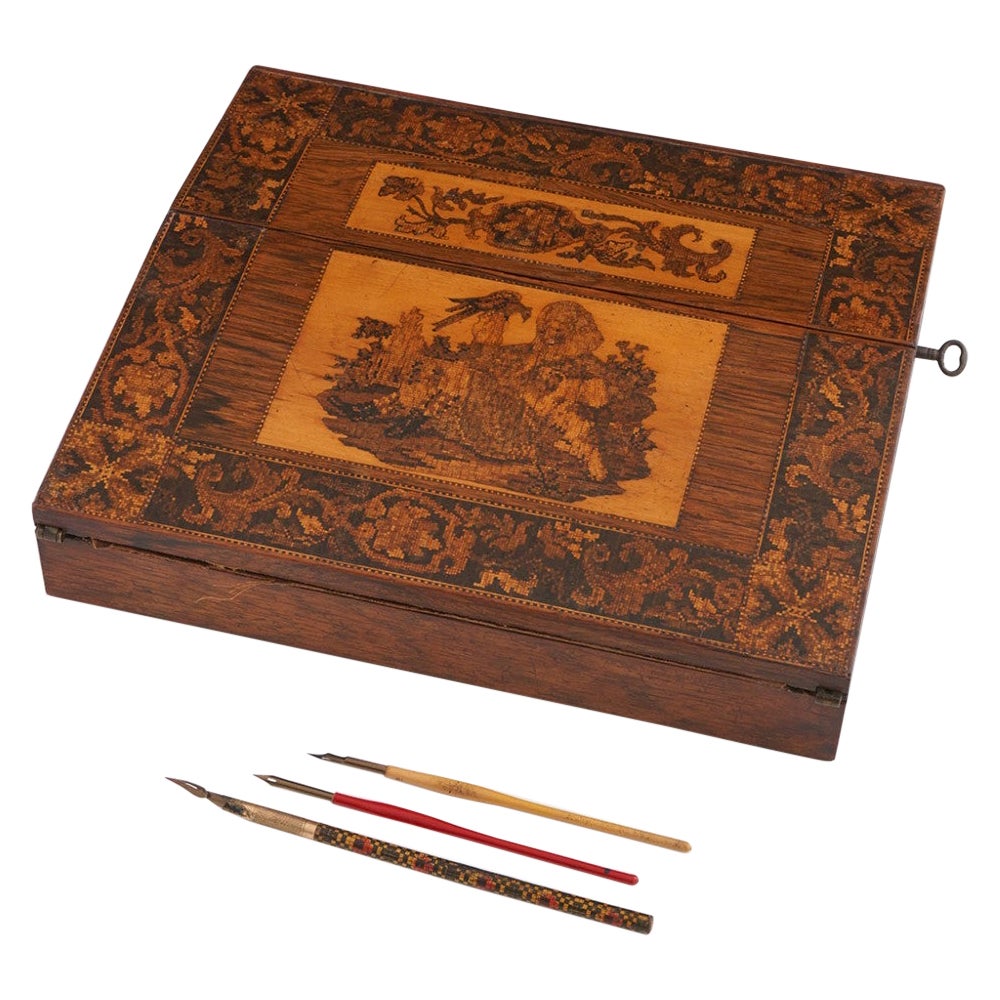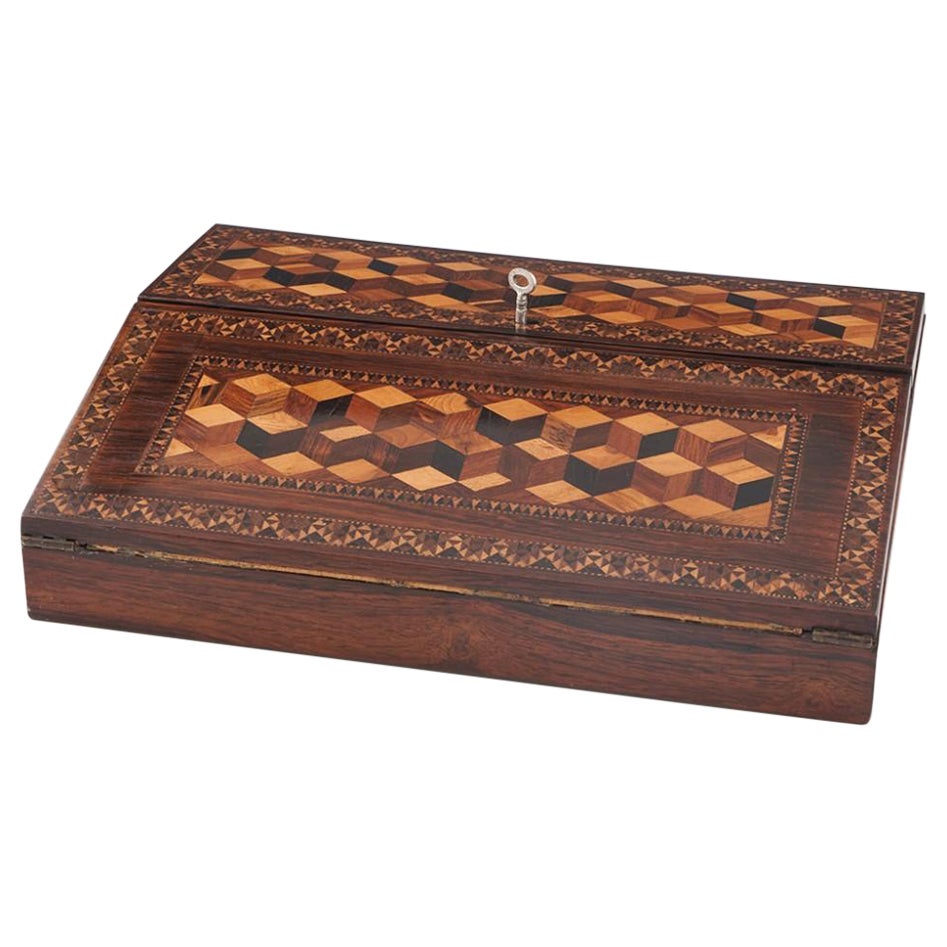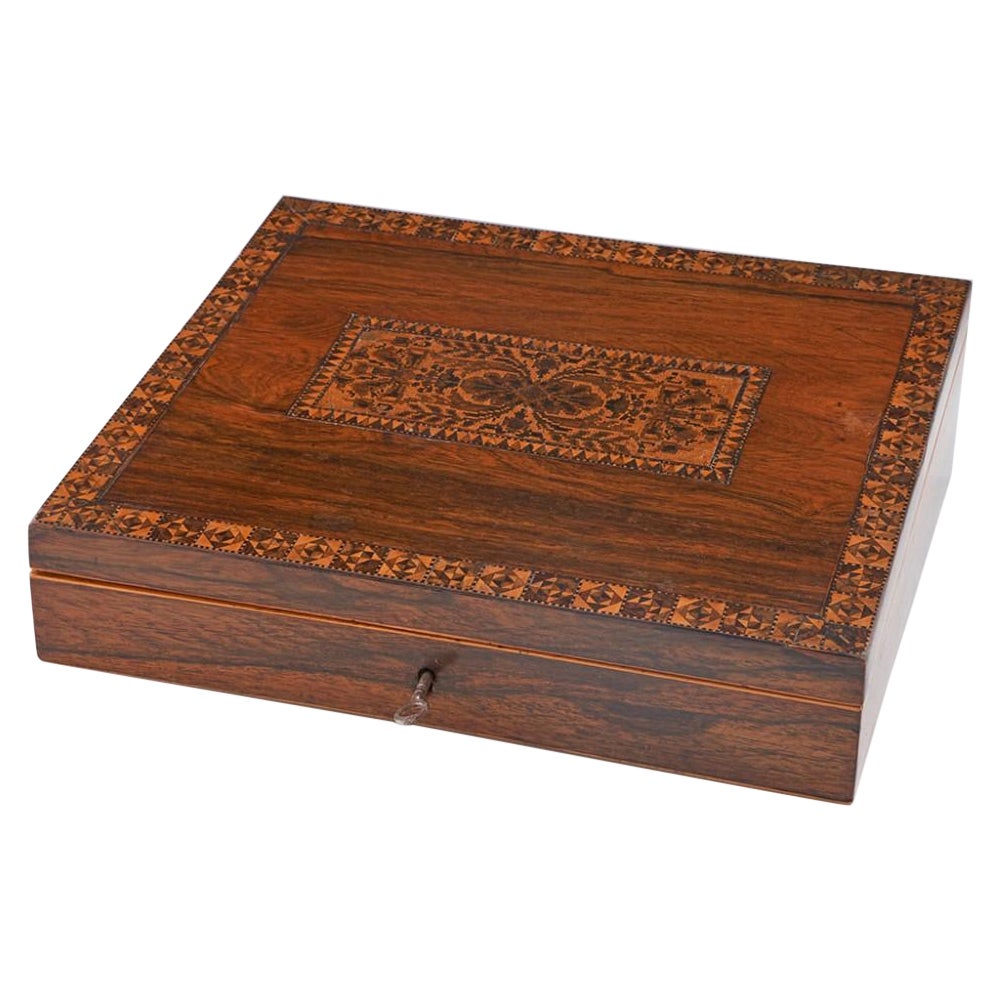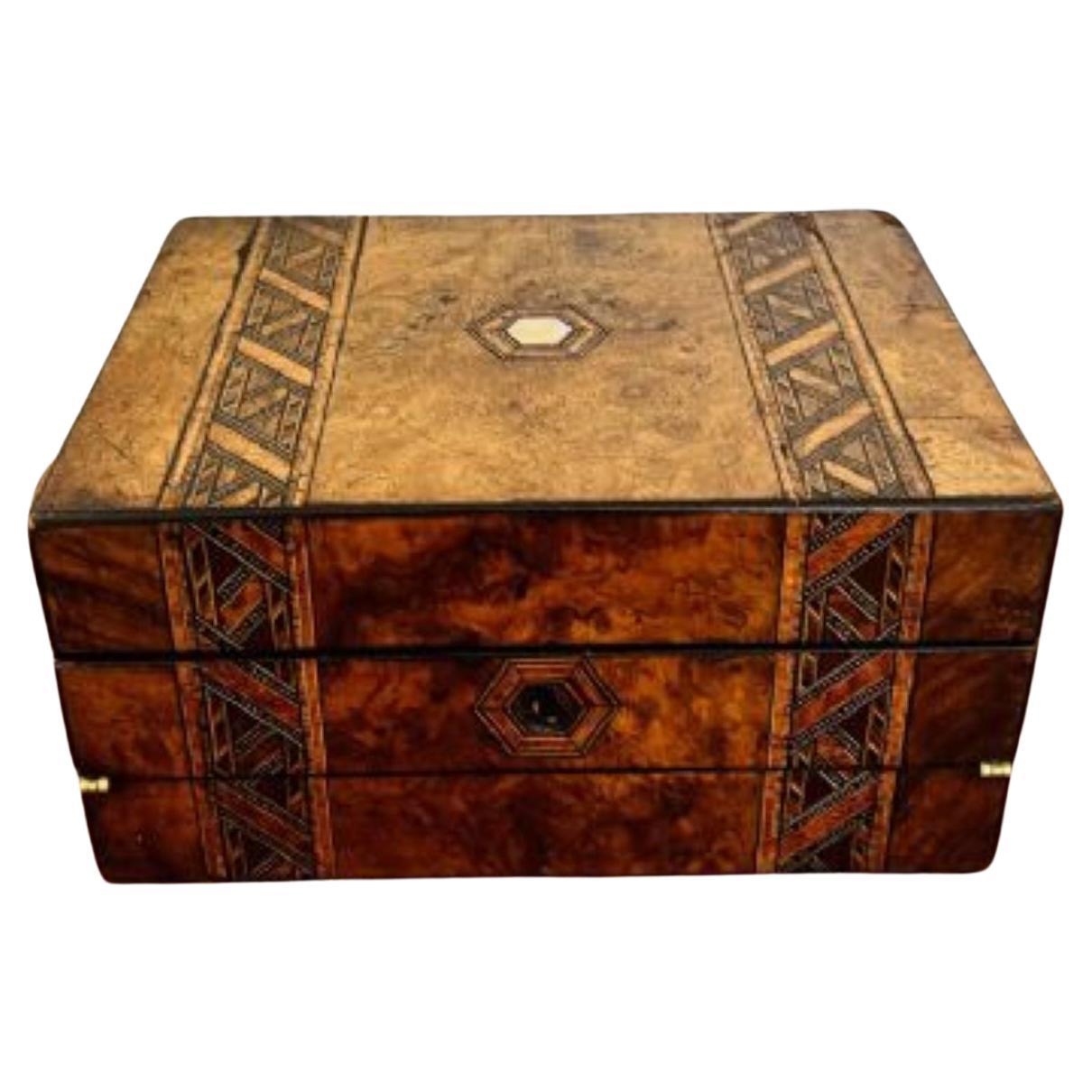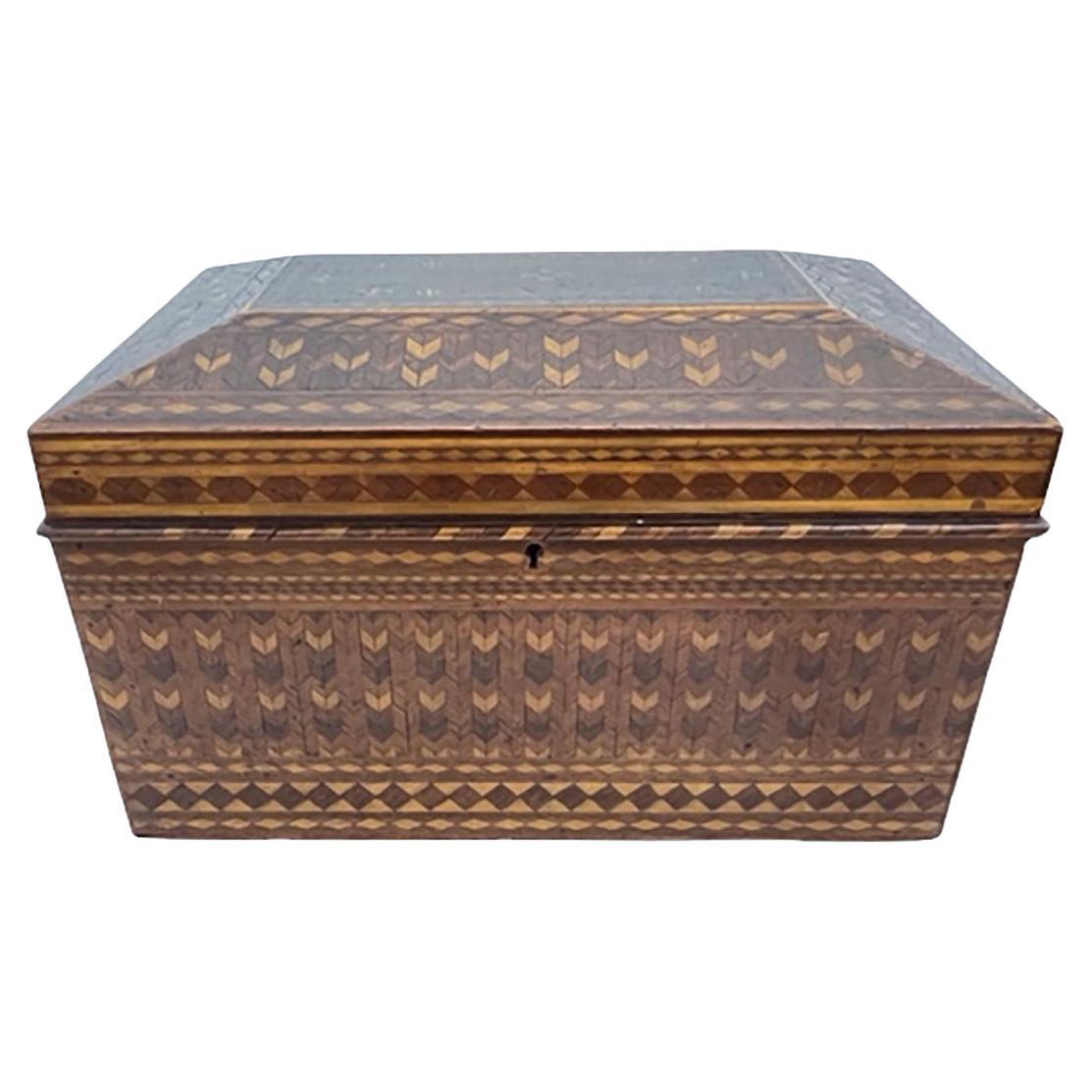Items Similar to Oversized Tunbridge Ware Writing Slope
Want more images or videos?
Request additional images or videos from the seller
1 of 18
Oversized Tunbridge Ware Writing Slope
About the Item
View of Bayham Abbey with Writing Implements
From our Tunbridge Ware collection, we are delighted to offer this unusual and large-sized Tunbridge Ware Writing Slope, in the manner of Henry Hollamby. The Writing Slope crafted from Rosewood is extensively decorated to the exterior with the renowned Tunbridge Ware inlaid woods with a band of oak leaves around the proximity of the body. The top features a view of Bayham Abbey, Kent, England with the central scene outlined by a flurry of roses within a squared border. To the right-hand side of the box when looking from a small escutcheon hidden in plain sight allows the user to lock the Writing Slope. When opened the box reveals the original purple Velvet Writing Slope, above the Slope are various compartments for storing writing implements and two ink wells. The box contains some further Tunbridge Ware writing tools which are featured in the photographs. The Slope pulls up via a tab located at the 12 o’clock position to allow access to the storage compartment below for documents or letters. The Tunbridge Ware Writing Slope dates to the second half of the 19th century Circa 1875.
Tunbridge Ware is a form of inlaid woodwork which is typically in the form of boxes, smaller objects and/or accessories that are characteristic of Tonbridge and the spa town of Royal Tunbridge Wells in Kent in the 18th and 19th centuries. The decoration consists of a mosaic of many very small pieces of different coloured woods combined to make a decorative scene.
Rosewood has many variations. Indian Rosewood, Madagascan Rosewood, Mexican Rosewood, Rio Rosewood, Brazilian Rosewood, San Dominican and Santos Rosewood. All types are prized for their grain and colour. Generally, the colours range from a medium-dark red-reddish brown.
- Dimensions:Height: 3.94 in (10 cm)Width: 16.93 in (43 cm)Depth: 12.8 in (32.5 cm)
- Style:High Victorian (Of the Period)
- Materials and Techniques:
- Place of Origin:
- Period:
- Date of Manufacture:Circa 1875
- Condition:Wear consistent with age and use.
- Seller Location:Northampton, GB
- Reference Number:
About the Seller
No Reviews Yet
Vetted Seller
These experienced sellers undergo a comprehensive evaluation by our team of in-house experts.
Established in 1998
1stDibs seller since 2023
14 sales on 1stDibs
Typical response time: <1 hour
- ShippingRetrieving quote...Ships From: Northampton, United Kingdom
- Return PolicyA return for this item may be initiated within 14 days of delivery.
More From This SellerView All
- Regency Tunbridge Ware Sewing BoxBy Tunbridge WareLocated in Northampton, GBFitted Interior & Silver Handles From our Tunbridge Ware collection, we are delighted to offer this Tunbridge Ware Sewing Box. The Sewing Bo...Category
Antique Early 19th Century British Regency Decorative Boxes
MaterialsSatinwood
- Brighton Pavilion Tunbridge Ware Sewing CompendiumBy Tunbridge WareLocated in Northampton, GBRare Tunbridge Ware Form Sewing Compendium From our Tunbridge Ware collection, we are delighted to offer this very rare Tunbridge Wear Sewing Compendium. The Sewing Compendium modelled as a tower from the Brighton Pavilion features the iconic minaret turned in Sycamore (aka white wood) and a large globular body with hand-painted details leading to further turned faces and the hand-painted windows upon a stepped base. The Sewing Compendium opens in two locations one just below the first dome revealing a pin cushion and the second just above the windows revealing the Sewing tools including a Tunbridge Ware thimble and bobbin. The Tunbridge Ware Sewing Compendium dates to the Georgian era during the reign of George IV circa 1825. Brighton Pavilion, The Royal Pavilion and surrounding gardens are a Grade I listed property and were the former Royal residence located in Brighton, England. It was built in 1787 in three stages as a seaside retreat for George, Prince of Wales who became the Prince Regent in 1811 and then King George IV in 1820. It is built in the Indo-Saracenic style prevalent in India for most of the 19th century. The current appearance of the Pavilion which has various domes and minarets, is the work of architect John Nash, who extended the building starting in 1815. George IV's successors William IV and Victoria also used the Pavilion but Queen Victoria decided that Osborne House should replace the Pavilion as the royal seaside retreat and therefore the Pavilion was sold to the city of Brighton in 1850. Indo-Sarascenic refers to a cross between Indian architecture and Muslim architecture. Minarets means beacon in Arabic. In Islamic religious architecture, the tower from which the faithful are called to prayer five times each day by a muezzin, or crier. Such a tower is connected to a mosque and has one or more balconies or open galleries. The inspiration for the minarets features on the Brighton Pavilion are in homage to these types of finials. John Nash (1752-1835) was one of the most prevalent British architects from the Georgian and Regency periods. He was responsible for the design, in the neoclassical and picturesque styles of many important areas of London. He was financed by the Prince Regent and by the era's most successful property developer, James Burton. Nash's most famous designs were the Brighton Pavilion, Marble Arch and Buckingham Palace. Sycamore is a member of the Maple family, found in Europe. It is light yellow in colour and is often a very clean wood, with a straight, fine grain. The wood is often pippy. However, these pips are usually a very similar colour to the rest of the wood making them hardly visible. Georgian, a period in British history dating from 1714-1837, the Georgian era after the Hanoverian kings George I, George II, George III and George IV. Tunbridge Ware Tunbridge Wells and Tunbridge in Kent, England became popular in the 17th Century for their therapeutic waters. By the 18th century, Tunbridge Wells was a hugely popular Spa resort. Shops and stalls were set up to sell local work of distinction to visitors as souvenirs. Many of the original boxes were decorated with all sorts of different kinds of designs. Many of the Tunbridge boxes...Category
Antique Early 19th Century British George IV Decorative Boxes
MaterialsWood, Sycamore
- Georgian Tunbridge Ware Folk Art Cottage Sewing BoxBy Tunbridge WareLocated in Northampton, GBTunbridge Ware Folk House Sewing Box From our Sewing Box collection, we are thrilled to offer this Novelty Folk Art Cottage Sewing Box. The box of rectangular form made from Sycamor...Category
Antique Early 1800s British Georgian Decorative Boxes
MaterialsWood, Sycamore
- Scottish Mauchline Ware Tea Caddy attributed to SmithsLocated in Northampton, GBScottish Mauchline Ware From our Tea Caddy collection, we are delighted to offer this rare Mauchline Ware Tea Caddy. The Tea Caddy of rectangular form extensively decorated with a repeating pinstripe pattern throughout the entire exterior of the Tea Caddy upon a Sycamore carcass. The decoration features a striped effect with alternating classical scrollwork, linked chain and pin striped vertical line transfers in shades of gold, green and red. A shield-shaped escutcheon finishes the exterior of the Caddy. When opened the Tea Caddy reveals a single Caddy compartment with traces of the original foil lining and the Caddy the original full length wooden Cumnock Hinge. The Tea Caddy dates to the late Georgian Period during the reign of George IV Circa 1830. The Tea Caddy is a rare example of early Mauchline Ware especially because of the Type of decoration used and extremely good condition, a superb addition to any collection. We firmly attribute the Tea Caddy to renowned Scottish Mauchline Ware makers Smiths from the extremely close similarities between this Caddy and a previous one in our archives signed by Smiths. The Tea Caddy comes complete with working lock and tasselled key. Mauchline Ware was the production of Scottish white-wood products, it was mainly manufactured from the 1820s until 1939. The production of souvenir woodware for the tourist market began in the 1790s with the snuff box industry in Ayrshire. By 1820, Mauchline ware was well established, supplying souvenirs from wood grown ‘on the Field of Bannockburn’, ‘on the Abbey Craig’, ‘on the slopes of Stirling Castle’ and made into sewing requisites, egg cups, trinket boxes and many other kinds of souvenirs, transfer printed with a line drawing of the place. The firm Smith’s who regarded as the the leading and most renowned manufacturer of Mauchline War among a few lesser known and shorter lived companies. They ranged from the basic transfer as on small vases to boxes and smaller household accessories...Category
Antique Early 19th Century Scottish William IV Tea Caddies
MaterialsSycamore
- Antique English Mother of Pearl & Rosewood Writing Box HausburgBy F.L. HausburgLocated in Northampton, GBFirmly Attributed to Hausburg From our Writing Box collection, we are pleased to offer this Antique Victorian Writing Box attributed to ...Category
Antique Mid-19th Century English Victorian Decorative Boxes
MaterialsPewter
- Antique Burr Walnut Writing Box by Betjemann with Rare Secret CompartmentBy George Betjemann & SonsLocated in Northampton, GBRetailed by Charles Henry, Manchester From our Writing Box collection, we are delighted to offer this English Burr Walnut Writing Box by Betjemann. The Writing box of slim rectangular shape with a slightly sloped lid is veneered in exquisite Burr Walnut to the exterior with beautifully shaped brass mounts. The escutcheon sits at the centre of the writing box on a brass mount which also features three monogrammed letters C F E. When opened the box reveals a royal blue velvet writing slope with a gold tooled border framed by an embossed greek key style border. The box is faced in exotic Coromandel wood which is a rare addition to this style of Writing Box. Above the writing slope, there is a partitioned section lined in Satinwood with two glass inkwells and a pen tray with further storage. The secret spring-loaded stationary drawer features a solid Satinwood base complete with small yet elegant dovetail joints, activated by pressing down on the button on the brass mounted plate reading 'Betjemann Patent'. The inside of the writing slope lid bears the retailer plaque 'Charles Henry Manchester.' The box also features the original owner's monogram with the letters "C F E" in multiple locations. The Writing Box comes complete with a working lock and tasselled key. George Betejemann & Sons was a celebrated British firm of cabinet makers and retailers founded in the mid-19th century. Renowned for their exquisite craftsmanship and attention to detail, the company quickly gained a reputation for producing some of the finest writing boxes and other luxury desk...Category
Antique Late 19th Century English Late Victorian Decorative Boxes
MaterialsBrass
You May Also Like
- Tunbridge Ware Writing Slope c1850By Tunbridge WareLocated in Tunbridge Wells, GBHeading : Tunbridge ware writing slope Date : c1875 Period : Victoria Origin : Tunbridge Wells, kent Decoration : Central mosaic of a child with small dog and bird. Above is a foliat...Category
Antique 1850s British Victorian Decorative Boxes
MaterialsWood
- A Very Fine Tunbridge Ware Writing Slope Box, c1850By Edmund Nye Tunbridge WellsLocated in Tunbridge Wells, GBA Very Fine Tunbridge Ware Writing Slope Box, c1850 Additional Information: Heading: A Very Fine Tunbridge Ware Writing Slope Date : c1850 and possibly a li...Category
Antique 19th Century English Victorian Decorative Boxes
MaterialsLeather, Wood
- Tunbridge Ware - An Early Writing Slope with Geometric Designs, c1835By Edmund Nye Tunbridge WellsLocated in Tunbridge Wells, GBTunbridge Ware - An Early Writing Slope with Geometric Designs, c1835 Additional Information: Heading: Tunbridge Ware - An Early Writing Slope with Geometric Designs Date : c1835 ...Category
Antique 19th Century English William IV Decorative Boxes
MaterialsRosewood
- Lovely antique Victorian tunbridge ware inlaid writing boxLocated in Ipswich, GBLovely antique Victorian tunbridge ware inlaid writing box having a lovely antique Victorian tunbridge ware inlaid wring box with beautiful detail to the box opening to reveal a pull...Category
Antique Early 19th Century Victorian Decorative Boxes
MaterialsWood
- Tunbridge Ware BoxLocated in Dallas, TXLarge Tunbridge ware box with herringbone pattern inlaid parquetry. Circa 1840, England.Category
Antique 1840s English Decorative Boxes
MaterialsWood
- 19th Century British Tunbridge Ware Lap DeskBy Tunbridge WareLocated in Dallas, TXPresenting an absolutely gorgeous and extremely unique and rare 19th Century British Tunbridge ware lap desk. This lap desk is unlike any of it’s kind we have seen before. From cir...Category
Antique Mid-19th Century English High Victorian Decorative Boxes
MaterialsMaple, Walnut, Satinwood, Ebony, Wood
